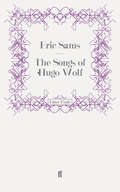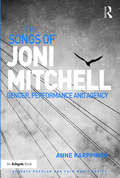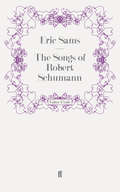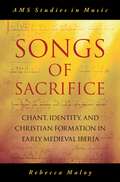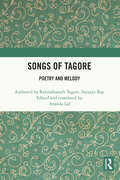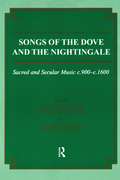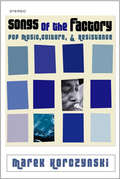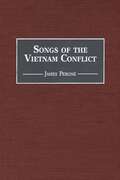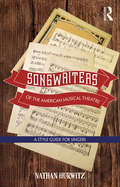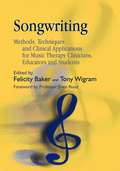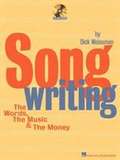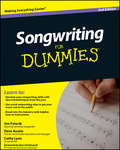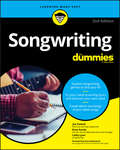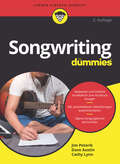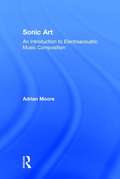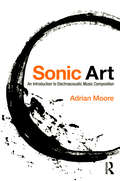- Table View
- List View
The Songs of Hugo Wolf
by Eric SamsWith a foreword by the legendary accompanist, Gerald Moore, Eric Sams' study (Faber 1961, revised 1983) is a notable landmark in the establishment of Wolf as one of the supreme masters of German song. Comprehensively revised and enlarged in 1983, the main subject matter remains the 242 published songs that Wolf wrote for voice and piano, though the Ibsen songs for voice and orchestra are also discussed.English translations are provided and the backgrounds to the original poems by Morike, Eichendorff and Goethe, as well as the Italian and Spanish sources from which the songbooks were drawn, are fully explored. Each song is dated, its keys identified and vocal range determined.'This is the most important book in the English language on the songs of Hugo Wolf since Ernest Newman proclaimed the composer's genius in 1907 . . . To the English-speaking student this work is a treasure to which he will find himself returning again and again: it is indispensable to those of us anxious to gain a deeper knowledge of Wolf.' Gerald Moore
The Songs of Joni Mitchell: Gender, Performance and Agency (Ashgate Popular and Folk Music Series)
by Anne KarppinenAn unorthodox musician from the start, singer-songwriter Joni Mitchell's style of composing, performing, and of playing (and tuning) the guitar is unique. In the framework of sexual difference and the gendered discourses of rock this immediately begs the questions: are Mitchell's songs specifically feminine and, if so, to what extent and why? Anne Karppinen addresses this question focusing on the kind of music and lyrics Mitchell writes, the representation of men and women in her lyrics, how her style changes and evolves over time, and how cultural context affects her writing. Linked to this are the concepts of subjectivity and authorship: when a singer-songwriter sings a song in the first person, about whom are they actually singing? Mitchell offers a fascinating study, for the songs she writes and sings are intricately woven from the strands of her own life. Using methods from critical discourse analysis, this book examines recorded performances of songs from Mitchell's first nine studio albums, and the contemporary reviews of these albums in Anglo-American rock magazines. In one of the only books to discuss Mitchell's recorded performances, with a focus that extends beyond the seminal album Blue, Karppinen explores the craft of Mitchell's songwriting and her own attitudes towards it, as well as the dynamics and politics of rock criticism in the 1960s and 1970s more generally.
The Songs of Joni Mitchell: Gender, Performance and Agency (Ashgate Popular and Folk Music Series)
by Anne KarppinenAn unorthodox musician from the start, singer-songwriter Joni Mitchell's style of composing, performing, and of playing (and tuning) the guitar is unique. In the framework of sexual difference and the gendered discourses of rock this immediately begs the questions: are Mitchell's songs specifically feminine and, if so, to what extent and why? Anne Karppinen addresses this question focusing on the kind of music and lyrics Mitchell writes, the representation of men and women in her lyrics, how her style changes and evolves over time, and how cultural context affects her writing. Linked to this are the concepts of subjectivity and authorship: when a singer-songwriter sings a song in the first person, about whom are they actually singing? Mitchell offers a fascinating study, for the songs she writes and sings are intricately woven from the strands of her own life. Using methods from critical discourse analysis, this book examines recorded performances of songs from Mitchell's first nine studio albums, and the contemporary reviews of these albums in Anglo-American rock magazines. In one of the only books to discuss Mitchell's recorded performances, with a focus that extends beyond the seminal album Blue, Karppinen explores the craft of Mitchell's songwriting and her own attitudes towards it, as well as the dynamics and politics of rock criticism in the 1960s and 1970s more generally.
The Songs of Robert Schumann
by Eric SamsEric Sams' study of Schumann's 246 songs (Faber 1961, revised 1993) - a companion volume to his The Songs of Hugo Wolf, also available in Faber Finds - remains a classic text. By providing a translation, commentary and notes for each of the songs, tracing original sources and relating recurring themes vividly to Schumann's life, Sams provides a unique documentary of Schumann's song-writing art.The book includes a foreword (to the First Edition) by the legendary accompanist, Gerald Moore,who writes:'So felicitous is the writing that one is hardly conscious of the erudition and profound thought that have gone into the making of it . . . Eric Sams has produced a work that will be read and read again as long as Robert Schumann's songs are loved.'
Songs of Sacrifice: Chant, Identity, and Christian Formation in Early Medieval Iberia (AMS Studies in Music)
by Rebecca MaloyBetween the seventh and eleventh centuries, Christian worship on the Iberian Peninsula was structured by rituals of great theological and musical richness, known as the Old Hispanic (or Mozarabic) rite. Much of this liturgy was produced during a seventh-century cultural and educational program aimed at creating a society unified in the Nicene faith, built on twin pillars of church and kingdom. Led by Isidore of Seville and subsequent generations of bishops, this cultural renewal effort began with a project of clerical education, facilitated through a distinctive culture of textual production. Rebecca Maloy's Songs of Sacrifice argues that liturgical music--both texts and melodies--played a central role in the cultural renewal of early Medieval Iberia, with a chant repertory that was carefully designed to promote the goals of this cultural renewal. Through extensive reworking of the Old Testament, the creators of the chant texts fashioned scripture in ways designed to teach biblical exegesis, linking both to patristic traditions--distilled through the works of Isidore of Seville and other Iberian bishops--and to Visigothic anti-Jewish discourse. Through musical rhetoric, the melodies shaped the delivery of the texts to underline these messages. In these ways, the chants worked toward the formation of individual Christian souls and a communal Nicene identity. Examining the crucial influence of these chants, Songs of Sacrifice addresses a plethora of long-debated issues in musicology, history, and liturgical studies, and reveals the potential for Old Hispanic chant to shed light on fundamental questions about how early chant repertories were formed, why their creators selected particular passages of scripture, and why they set them to certain kinds of music.
Songs of Sacrifice: Chant, Identity, and Christian Formation in Early Medieval Iberia (AMS Studies in Music)
by Rebecca MaloyBetween the seventh and eleventh centuries, Christian worship on the Iberian Peninsula was structured by rituals of great theological and musical richness, known as the Old Hispanic (or Mozarabic) rite. Much of this liturgy was produced during a seventh-century cultural and educational program aimed at creating a society unified in the Nicene faith, built on twin pillars of church and kingdom. Led by Isidore of Seville and subsequent generations of bishops, this cultural renewal effort began with a project of clerical education, facilitated through a distinctive culture of textual production. Rebecca Maloy's Songs of Sacrifice argues that liturgical music--both texts and melodies--played a central role in the cultural renewal of early Medieval Iberia, with a chant repertory that was carefully designed to promote the goals of this cultural renewal. Through extensive reworking of the Old Testament, the creators of the chant texts fashioned scripture in ways designed to teach biblical exegesis, linking both to patristic traditions--distilled through the works of Isidore of Seville and other Iberian bishops--and to Visigothic anti-Jewish discourse. Through musical rhetoric, the melodies shaped the delivery of the texts to underline these messages. In these ways, the chants worked toward the formation of individual Christian souls and a communal Nicene identity. Examining the crucial influence of these chants, Songs of Sacrifice addresses a plethora of long-debated issues in musicology, history, and liturgical studies, and reveals the potential for Old Hispanic chant to shed light on fundamental questions about how early chant repertories were formed, why their creators selected particular passages of scripture, and why they set them to certain kinds of music.
Songs of Tagore: Poetry and Melody
by Rabindranath Tagore Satyajit RayRabindranath Tagore composed over 2000 songs that are revered and sung by Bengalis everywhere. However, they remain mostly unknown to listeners from other communities. This book brings the Nobel Laureate’s unique music — Rabindrasangit — to a global audience, with a lucid introduction by Ananda Lal as well as selected songs in international transcription and English translation. It includes an essay written originally in Bengali by the celebrated filmmaker Satyajit Ray, himself a Tagore student and music composer. Ray presents his thoughts on Rabindrasangit, its nuances, music, history, and usage. Lal has also translated this essay into English for the first time. The book also presents for the first time faithful staff notations of all 41 songs in three of Tagore’s major plays — Rakta-karavi, Tapati, and Arup Ratan — providing a thematic unity to the music section. This volume will be of interest to Tagore and Ray enthusiasts and specialists, musicologists, and students of music, theatre, literature, performance studies, and cultural studies. It will appeal not only to scholars but to general readers wanting to know more about Tagore’s songs, as well as directors, arrangers, composers, and singers who may wish to perform or interpret the songs transcribed.
Songs of Tagore: Poetry and Melody
by Rabindranath Tagore Satyajit RayRabindranath Tagore composed over 2000 songs that are revered and sung by Bengalis everywhere. However, they remain mostly unknown to listeners from other communities. This book brings the Nobel Laureate’s unique music — Rabindrasangit — to a global audience, with a lucid introduction by Ananda Lal as well as selected songs in international transcription and English translation. It includes an essay written originally in Bengali by the celebrated filmmaker Satyajit Ray, himself a Tagore student and music composer. Ray presents his thoughts on Rabindrasangit, its nuances, music, history, and usage. Lal has also translated this essay into English for the first time. The book also presents for the first time faithful staff notations of all 41 songs in three of Tagore’s major plays — Rakta-karavi, Tapati, and Arup Ratan — providing a thematic unity to the music section. This volume will be of interest to Tagore and Ray enthusiasts and specialists, musicologists, and students of music, theatre, literature, performance studies, and cultural studies. It will appeal not only to scholars but to general readers wanting to know more about Tagore’s songs, as well as directors, arrangers, composers, and singers who may wish to perform or interpret the songs transcribed.
Songs of the Dove and the Nightingale: Sacred and Secular Music c.900-c.1600 (Musicology)
by Greta Mary Hair Robyn E. SmithFirst Published in 1995. Routledge is an imprint of Taylor & Francis, an informa company.
Songs of the Dove and the Nightingale: Sacred and Secular Music c.900-c.1600 (Musicology #17)
by Greta Mary Hair Robyn E. SmithFirst Published in 1995. Routledge is an imprint of Taylor & Francis, an informa company.
Songs of the Factory: Pop Music, Culture, and Resistance
by Marek KorczynskiIn Songs of the Factory, Marek Korczynski examines the role that popular music plays in workers’ culture on the factory floor. Reporting on his ethnographic fieldwork in a British factory that manufactures window blinds, Korczynski shows how workers make often-grueling assembly-line work tolerable by permeating their workday with pop music on the radio. The first ethnographic study of musical culture in an industrial workplace, Songs of the Factory draws on socio-musicology, cultural studies, and sociology of work, combining theoretical development, methodological innovation, and a vitality that brings the musical culture of the factory workers to life.Music, Korczynski argues, allows workers both to fulfill their social roles in a regimented industrial environment and to express a sense of resistance to this social order. The author highlights the extensive forms of informal collective resistance within this factory, and argues that the musically informed culture played a key role in sustaining these collective acts of resistance. As well as providing a rich picture of the musical culture and associated forms of resistance in the factory, Korczynski also puts forward new theoretical concepts that have currency in other workplaces and in other rationalized spheres of society.
Songs of the Vietnam Conflict (Music Reference Collection)
by James E. PeroneOffering the widest scope of any study of one of popular music's most important eras, Songs of the Vietnam Conflict treats both anti-war and pro-government songs of the 1960s and early 1970s, from widely known selections such as Give Peace a Chance and Blowin' in the Wind to a variety of more obscure works. These are songs that permeated the culture, through both recordings and performances at political gatherings and concerts alike, and James Perone explores the complex relationship between music and the society in which it is written. This music is not merely an indicator of the development of the American popular song; it both reflected and shaped the attitudes of all who were exposed to it.Whereas in previous wars, musicians rallied behind the government in the way of Aaron Copland and Samuel Barber, the Vietnam conflict provoked anger, frustration, and rage, all of which comes through in the songs of the time. This reference work provides indispensable coverage of this phenomenon, in chapters devoted to Anti-War Songs, Pro-Government Songs, and what might be called Plight-of-the-Soldier (or Veteran) songs. A selected discography guides the reader to the most notable recordings, all of which, together, provide a unique and important perspective on perhaps the 20th century's most contentious time.
Songwriters of the American Musical Theatre: A Style Guide for Singers
by Nathan HurwitzFrom the favorites of Tin Pan Alley to today’s international blockbusters, the stylistic range required of a musical theatre performer is expansive. Musical theatre roles require the ability to adapt to a panoply of characters and vocal styles. By breaking down these styles and exploring the output of the great composers, Songwriters of the American Musical Theatre offers singers and performers an essential guide to the modern musical. Composers from Gilbert and Sullivan and Irving Berlin to Alain Boublil and Andrew Lloyd Webber are examined through a brief biography, a stylistic overview, and a comprehensive song list with notes on suitable voice types and further reading. This volume runs the gamut of modern musical theatre, from English light opera through the American Golden Age, up to the "mega musicals" of the late Twentieth Century, giving today’s students and performers an indispensable survey of their craft.
Songwriters of the American Musical Theatre: A Style Guide for Singers
by Nathan HurwitzFrom the favorites of Tin Pan Alley to today’s international blockbusters, the stylistic range required of a musical theatre performer is expansive. Musical theatre roles require the ability to adapt to a panoply of characters and vocal styles. By breaking down these styles and exploring the output of the great composers, Songwriters of the American Musical Theatre offers singers and performers an essential guide to the modern musical. Composers from Gilbert and Sullivan and Irving Berlin to Alain Boublil and Andrew Lloyd Webber are examined through a brief biography, a stylistic overview, and a comprehensive song list with notes on suitable voice types and further reading. This volume runs the gamut of modern musical theatre, from English light opera through the American Golden Age, up to the "mega musicals" of the late Twentieth Century, giving today’s students and performers an indispensable survey of their craft.
Songwriting: Methods, Techniques and Clinical Applications for Music Therapy Clinicians, Educators and Students
by Emma Davies Tony Wigram Lucanne Magill Jeanette Kennelly Felicity Baker Jeanette Tamplin Amelia OldfieldThis comprehensive and groundbreaking book describes the effective use of songwriting in music therapy with a variety of client populations, from children with cancer and adolescents in secondary school to people with traumatic brain injury and mental health problems. The authors explain the specific considerations to bear in mind when working with particular client groups to achieve the best clinical outcomes. All the contributors are experienced music therapy clinicians and researchers. They provide many case examples from clinical practice to illustrate the therapeutic methods being used, together with notated examples of songs produced in therapy. Particular emphasis is placed on how lyrics and music are created, including the theoretical approaches underpinning this process. This practical book will prove indispensable to students, clinical therapists, music therapists, educators, teachers and musicians.
Songwriting: Methods, Techniques and Clinical Applications for Music Therapy Clinicians, Educators and Students (PDF)
by Amelia Oldfield Emma Davies Felicity Baker Jeanette Kennelly Jeanette Tamplin Lucanne Magill Tony WigramThis comprehensive and groundbreaking book describes the effective use of songwriting in music therapy with a variety of client populations, from children with cancer and adolescents in secondary school to people with traumatic brain injury and mental health problems. The authors explain the specific considerations to bear in mind when working with particular client groups to achieve the best clinical outcomes. All the contributors are experienced music therapy clinicians and researchers. They provide many case examples from clinical practice to illustrate the therapeutic methods being used, together with notated examples of songs produced in therapy. Particular emphasis is placed on how lyrics and music are created, including the theoretical approaches underpinning this process. This practical book will prove indispensable to students, clinical therapists, music therapists, educators, teachers and musicians.
Songwriting: The Words, The Music and The Money (PDF) (Songwriting And Lyrics Ser.)
by Dick WeissmanAn excellent and essential primer for the aspiring tunesmith, Songwriting: The Words, the Music & Money offers authoritative tips on everything from basic song forms to the hard facts of succeeding in the music business. In between, veteran songwriter Dick Weissman shares his insights into composing effective lyrics, melodies and hooks, as well as detailed breakdowns of every musical style from folk to cabaret to hip hop. The first book on the topic to be accompanied by a CD covering all the musical concepts explored within, this is an invaluable resource for anyone engaged in the serious study of songwriting. No knowledge of musical notation is required. Dick Weissman is an Associate Professor of Music Business Management at the University of Colorado, and the former National Education Coordinator for the National Academy of Recording Arts and Sciences.
Songwriting For Dummies (For Dummies)
by Dave Austin Jim Peterik Cathy Lynn AustinProven techniques for songwriting success This friendly, hands-on guide tackles the new face of the recording industry, guiding you through the shift from traditional sales to downloads and mobile music, as well as how you can harness social media networks to get your music "out there." You get basic songwriting concepts, insider tips and advice, and inspiration for writing — and selling — meaningful, timeless songs. Songwriting 101 — get a grip on everything you need to know to write a song, from learning to listen to your "inner voice" to creating a "mood" and everything in between Jaunt around the genres — discover the variety of musical genres and find your fit, whether it's rock, pop, R&B, gospel, country, or more Let the lyrics out — master the art of writing lyrics, from finding your own voice to penning the actual words to using hooks, verses, choruses, and bridges Make beautiful music — find your rhythm, make melodies, and use chords to put the finishing touches on your song Work the Web — harness online marketing and social networks like Facebook, Twitter, and others to get your music heard by a whole new audience Open the book and find: What you need to know before you write a single note Tips on finding inspiration Ways to use poetic devices in lyrics Computer and Web-based shortcuts and technologies to streamline songwriting A look at famous songwriting collaborators Writing for stage, screen, and television How to make a demo to get your song heard Advice on how to make money from your music Learn to: Develop your songwriting skills with tips and techniques from the pros Use social networking sites to get your music out to the public Break into the industry with helpful, how-to instructions
Songwriting For Dummies
by Dave Austin Jim Peterik Cathy Lynn AustinProven techniques for songwriting success This friendly, hands-on guide tackles the new face of the recording industry, guiding you through the shift from traditional sales to downloads and mobile music, as well as how you can harness social media networks to get your music "out there." You get basic songwriting concepts, insider tips and advice, and inspiration for writing — and selling — meaningful, timeless songs. Songwriting 101 — get a grip on everything you need to know to write a song, from learning to listen to your "inner voice" to creating a "mood" and everything in between Jaunt around the genres — discover the variety of musical genres and find your fit, whether it's rock, pop, R&B, gospel, country, or more Let the lyrics out — master the art of writing lyrics, from finding your own voice to penning the actual words to using hooks, verses, choruses, and bridges Make beautiful music — find your rhythm, make melodies, and use chords to put the finishing touches on your song Work the Web — harness online marketing and social networks like Facebook, Twitter, and others to get your music heard by a whole new audience Open the book and find: What you need to know before you write a single note Tips on finding inspiration Ways to use poetic devices in lyrics Computer and Web-based shortcuts and technologies to streamline songwriting A look at famous songwriting collaborators Writing for stage, screen, and television How to make a demo to get your song heard Advice on how to make money from your music Learn to: Develop your songwriting skills with tips and techniques from the pros Use social networking sites to get your music out to the public Break into the industry with helpful, how-to instructions
Songwriting For Dummies
by Jim Peterik Dave Austin Cathy Lynn AustinProven techniques for songwriting success This friendly, hands-on guide tackles the new face of the recording industry, guiding you through the shift from traditional sales to downloads and mobile music, as well as how you can harness social media networks to get your music "out there." You get basic songwriting concepts, insider tips and advice, and inspiration for writing — and selling — meaningful, timeless songs. Songwriting 101 — get a grip on everything you need to know to write a song, from learning to listen to your "inner voice" to creating a "mood" and everything in between Jaunt around the genres — discover the variety of musical genres and find your fit, whether it's rock, pop, R&B, gospel, country, or more Let the lyrics out — master the art of writing lyrics, from finding your own voice to penning the actual words to using hooks, verses, choruses, and bridges Make beautiful music — find your rhythm, make melodies, and use chords to put the finishing touches on your song Work the Web — harness online marketing and social networks like Facebook, Twitter, and others to get your music heard by a whole new audience Open the book and find: What you need to know before you write a single note Tips on finding inspiration Ways to use poetic devices in lyrics Computer and Web-based shortcuts and technologies to streamline songwriting A look at famous songwriting collaborators Writing for stage, screen, and television How to make a demo to get your song heard Advice on how to make money from your music Songwriting For Dummies, 2nd Edition (9781119675655) was previously published as Songwriting For Dummies, 2nd Edition (9780470615140). While this version features a new Dummies cover and design, the content is the same as the prior release and should not be considered a new or updated product.
Songwriting For Dummies (For Dummies Ser.)
by Jim Peterik Dave Austin Cathy Lynn AustinProven techniques for songwriting success This friendly, hands-on guide tackles the new face of the recording industry, guiding you through the shift from traditional sales to downloads and mobile music, as well as how you can harness social media networks to get your music "out there." You get basic songwriting concepts, insider tips and advice, and inspiration for writing — and selling — meaningful, timeless songs. Songwriting 101 — get a grip on everything you need to know to write a song, from learning to listen to your "inner voice" to creating a "mood" and everything in between Jaunt around the genres — discover the variety of musical genres and find your fit, whether it's rock, pop, R&B, gospel, country, or more Let the lyrics out — master the art of writing lyrics, from finding your own voice to penning the actual words to using hooks, verses, choruses, and bridges Make beautiful music — find your rhythm, make melodies, and use chords to put the finishing touches on your song Work the Web — harness online marketing and social networks like Facebook, Twitter, and others to get your music heard by a whole new audience Open the book and find: What you need to know before you write a single note Tips on finding inspiration Ways to use poetic devices in lyrics Computer and Web-based shortcuts and technologies to streamline songwriting A look at famous songwriting collaborators Writing for stage, screen, and television How to make a demo to get your song heard Advice on how to make money from your music Songwriting For Dummies, 2nd Edition (9781119675655) was previously published as Songwriting For Dummies, 2nd Edition (9780470615140). While this version features a new Dummies cover and design, the content is the same as the prior release and should not be considered a new or updated product.
Songwriting für Dummies (Für Dummies)
by Jim Peterik Dave Austin Cathy LynnVon der Song-Idee zur Hitsingle: In diesem Buch finden Sie alles, was Sie wissen müssen, um mit Ihrem Song in der Musikindustrie Erfolg zu haben. Finden Sie den Stil, Rhythmus und Reim, der zu Ihrem Genre passt, und fesseln Sie Ihre Zuhörer mit eingängigen Texten und unvergesslichen Melodien. Mit vielen Übungen und Beispielen unterstützen die Autoren Sie bei den grundlegenden, kreativen Elementen des Songwriting, aber auch bei dem, was danach kommt: Demotape, Online-Marketing, digitale Downloads, Urheberrecht, Verträge, Agenten und Plattenfirmen - so lernen Sie, wie Sie mit Ihren Werken die größten Erfolge erzielen können.
Sonic Art: An Introduction To Electroacoustic Composition (PDF)
by Adrian MooreWritten by an active composer, performer and educator, Sonic Art: An Introduction to Electroacoustic Music Compositionprovides a clear and informative introduction to the compositional techniques behind electroacoustic music. It brings together theory, aesthetics, context and practical applications to allow students to start thinking about sound creatively, and gives them the tools to compose meaningful sonic art works. In addition to explaining the techniques and philosophies of sonic art, the book examines over forty composers and their works, introducing the history and context of notable pieces, and includes chapters on how to present compositions professionally, in performance and online. The book is supported by an online software toolkit which enables readers to start creating their own compositions. Encouraging a 'hands on' approach to working with sound, Sonic Artis the perfect introduction for anyone interested in electroacoustic music and crafting art from sounds.
Sonic Art: An Introduction to Electroacoustic Music Composition
by Adrian MooreWritten by an active composer, performer and educator, Sonic Art: An Introduction to Electroacoustic Music Composition provides a clear and informative introduction to the compositional techniques behind electroacoustic music. It brings together theory, aesthetics, context and practical applications to allow students to start thinking about sound creatively, and gives them the tools to compose meaningful sonic art works. In addition to explaining the techniques and philosophies of sonic art, the book examines over forty composers and their works, introducing the history and context of notable pieces, and includes chapters on how to present compositions professionally, in performance and online. The book is supported by an online software toolkit which enables readers to start creating their own compositions. Encouraging a ‘hands on’ approach to working with sound, Sonic Art is the perfect introduction for anyone interested in electroacoustic music and crafting art from sounds.
Sonic Art: An Introduction to Electroacoustic Music Composition
by Adrian MooreWritten by an active composer, performer and educator, Sonic Art: An Introduction to Electroacoustic Music Composition provides a clear and informative introduction to the compositional techniques behind electroacoustic music. It brings together theory, aesthetics, context and practical applications to allow students to start thinking about sound creatively, and gives them the tools to compose meaningful sonic art works. In addition to explaining the techniques and philosophies of sonic art, the book examines over forty composers and their works, introducing the history and context of notable pieces, and includes chapters on how to present compositions professionally, in performance and online. The book is supported by an online software toolkit which enables readers to start creating their own compositions. Encouraging a ‘hands on’ approach to working with sound, Sonic Art is the perfect introduction for anyone interested in electroacoustic music and crafting art from sounds.
